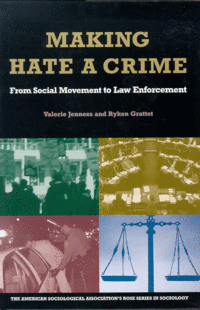

![]()
![]()

The authors focus on the political processes involved in the development of hate crime legislation as a unique form of public policy. They highlight the roles of social movements in politicizing the issue of hate crimes and in drawing attention to the levels of hate crime victimization experienced by specific groups. Hate crimes are a particularly vicious form of criminal activity because they are directed at a person's social attributes (such as their sexuality, race, religion, gender or disability) rather than anything unique to the individual. Therefore hate crimes have two victims – the individual and the community to which they belong. Social movements have therefore played a key role in publicizing hate crimes against their communities.
This book also focuses on the evolution of state legislation around hate crimes. Various legal strategies employed in the development of hate crimes legislation (such as embedding hate crime statutes within existing legislation or enacting penalty enhancement statutes) are also discussed. The elaboration and refinement of the concept of hate crime through judicial decision making is also identified as an important step in the evolution of public policy. Law enforcement responses to hate crimes, including the introduction of hate crime training for police officers, the establishment of distinct units to prosecute hate crimes, and variations in organizational responses to the issue of hate crime, are also outlined.
Some critics of hate crime legislation suggest that the entire concept of 'hate crimes' is so broad and vague as to be impossible to prosecute. However, Jenness and Grattet argue that after the concept had been clarified through judicial decision-making (essentially by likening hate crimes to other forms of discrimination), it has been routinized in police training and prosecution procedures and has led to many successful prosecutions. Hate crimes are no more difficult to enforce than other laws, but they rely on the willingness of victims to report incidents and the preparedness of police to prosecute such crimes. Jenness and Grattet indicate that there is a great deal of variation across police departments in terms of their knowledge, training and commitment to the effective policing of hate crimes.
This book is a significant contribution to both the literature on public policy more generally, and the literature on hate crimes in particular. However, my major criticism is that the authors take a problematic position with regard to those groups who traditionally experience high rates of hate crime victimization. They argue that a "victim ideology and corresponding victim industry" has emerged in America where social movements gain more resources by claming to be more victimized (p.28). I think researchers need to be careful in making such an argument, because they may underemphasize the roles of perpetrators and their power in the creation of hate crimes. The process of "victim blaming" has historically been an integral element of the oppression of minority groups, and their mobilization around hate crimes reflects a position of social and cultural weakness, rather than strength. Discrimination is not evenly socially distributed, and hate crimes are usually directed towards disempowered groups. Therefore we need to be careful in attributing a "victim ideology" to those groups who experience the highest levels of violence and abuse in their lives, so that we do not further contribute to victim blaming.
Mark Sherry
Oregon Health Sciences University